OECD report paints surprising picture of migrants
Migrants and refugees living in some of the world’s wealthiest countries are faring better in areas like education, jobs and integration than they were a decade ago, according to a new report by the Paris-based OECD.
The report says the number of newcomers arriving in the OECD’s 38 member states – representing the world’s most advanced economies – has jumped 20 per cent over the last 10 years.
About one in four OECD residents under 35 were born elsewhere.
 The report points out that despite repeated far right and anti-immigrant rhetoric that there is an immigration crisis in Europe, the reality is that things have improved.
The report points out that despite repeated far right and anti-immigrant rhetoric that there is an immigration crisis in Europe, the reality is that things have improved.
In a number of key areas, newcomers have made significant strides in recent years, the study says.
“Immigrants are a lot more qualified and educated than they were 10 or 20 years ago,” said OECD administrator Thomas Liebig.
“There also has been a lot of investment in integration policies and in the critical schooling years for children” including pre-school,” he said.
In countries like the US migrants are learning the language of their new home more quickly than before. Many, especially men, are also finding it easier to land jobs.
“We have better labour market conditions and the migrants seem to benefit disproportionately from them,” Mr Liebig said.
Over the past decade, the European Union has been rocked by Islamist terrorist attacks and a refugee crisis, the report says.
Anti-immigrant and right-wing politicians are gaining ground in Italy, France and the US. And Brexit – partly intended to “regain control” of immigration – has become reality in Britain, it said.
“Fuelling these movements are overly simplified or inaccurate perceptions of immigrants in social and mainstream media,” Mr Liebig said.
But the facts paint a different picture. Many European immigrants, for instance, come from other European nations. Most, too, come legally.
“By far the vast majority of migrant arrivals come by regular channels, with a visa. It’s a relatively small part that crosses the Mediterranean. But it’s much easier to show a picture of a boat than someone queuing up in an airport line with a passport,” Mr Liebig said.
And despite anti-immigration rhetoric in some places, public perception has not soured on the newcomers in recent years.
In Europe, surveys point to roughly half of native-born residents with no strong positive or negative views of immigration, the study found.
The other half is roughly divided between those believing immigrants have made their countries a better place – and those who don’t.
Sentiments are stronger in the US, but even so, there is not a single, broad anti-immigrant current, the report says.
Even in Britain – where curbing immigration played a key role in a 2016 referendum to leave the EU – the study found the number of British believing immigration was good for their economy actually doubled since 2010.
“People don’t always think about the economy. They may just not want to have too many migrants,” Mr Liebig said
But not all the report’s findings are positive.
More immigrants are still likely to be poor, live in substandard housing and have more health problems than natives of OECD countries.
There are fewer immigrant women in the labour market and rising numbers of elderly immigrants often face hard times.
Refugees, too, struggle to find jobs and move forward. Europe’s nearly five million Ukrainian refugees – many of them women – count among the rare success stories.
They are boosted by their generally high educational levels and social networks built by a large Ukrainian diaspora that arrived before the war.
Countries like Sweden, with strong integration programs for arriving immigrants, are also seeing positive outcomes.
“It’s worth thinking about integration as an investment that’s likely to pay off. Not only in economic terms, but in the future cohesion of our societies,” Mr Liebig said.












